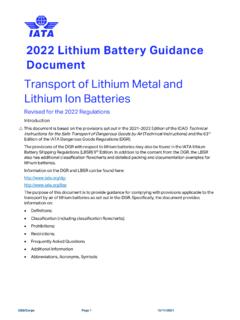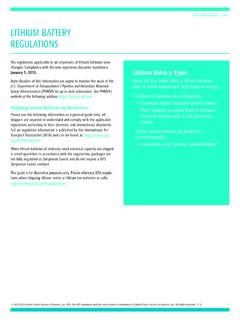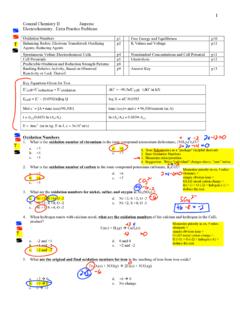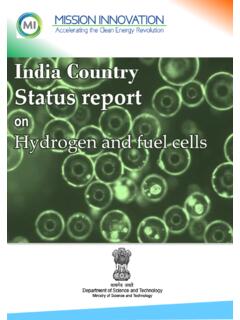Transcription of Hydrogen Production: Conference Paper
1 Conference Paper NREL/CP-550-47302 January 2010 Hydrogen Production: Fundamentals and Cas Study Summaries ePreprint Harrison, R. Remick, and Martin National Renewable Energy Laboratory A. Hoskin Natural Resources Canada To be presented at the 18th World Hydrogen Energy Conference Essen, Germany May 16 21, 2010 NOTICE The submitted manuscript has been offered by an employee of the Alliance for Sustainable Energy, LLC (ASE), a contractor of the US Government under Contract No. DE-AC36-08-GO28308. Accordingly, the US Government and ASE retain a nonexclusive royalty-free license to publish or reproduce the published form of this contribution, or allow others to do so, for US Government purposes. This report was prepared as an account of work sponsored by an agency of the United States government.
2 Neither the United States government nor any agency thereof, nor any of their employees, makes any warranty, express or implied, or assumes any legal liability or responsibility for the accuracy, completeness, or usefulness of any information, apparatus, product, or process disclosed, or represents that its use would not infringe privately owned rights. Reference herein to any specific commercial product, process, or service by trade name, trademark, manufacturer, or otherwise does not necessarily constitute or imply its endorsement, recommendation, or favoring by the United States government or any agency thereof. The views and opinions of authors expressed herein do not necessarily state or reflect those of the United States government or any agency thereof.
3 Available electronically at Available for a processing fee to Department of Energy and its contractors, in Paper , from: Department of Energy Office of Scientific and Technical Information Box 62 Oak Ridge, TN 37831-0062 phone: fax: email: Available for sale to the public, in Paper , from: Department of Commerce National Technical Information Service 5285 Port Royal Road Springfield, VA 22161 phone: fax: email: online ordering: Printed on Paper containing at least 50% wastepaper, including 20% postconsumer waste iii List of Acronyms and Abbreviations AC alternating current AC/DC AC-to-DC atm atmosphere BEPC Basin Electric Power Cooperative Btu British thermal units DC direct current DC/DC DC-to-DC DOE Department of Energy F Faraday constant G Gibbs free energy H enthalpy HARI Hydrogen and Renewables Integration HHV higher heating value IC internal combustion JANAF Joint Army-Navy-Air Force kJ kilojoule kWe kilowatt electrical kWh kilowatt hours LHV lower heating value mol mole MPPT maximum power point tracking NREL National Renewable Energy Laboratory Nm3 normal cubic meter NWTC National Wind Technology Center PEM polymer electrolyte membrane PV photovoltaic RE renewable energy S entropy V volt Wind2H2 Wind-to- Hydrogen
4 Project iv Table of Contents List of Acronyms and Abbreviations .. iii Heating Value, Heat of Reaction, and Free Energy .. 1 Heat of Combustion and Heat of Reaction .. 1 Standard Conditions .. 1 Free Energy .. 2 Heat of Formation and Free Energy of Formation .. 2 Calculating Fuel Cell System Efficiency .. 3 Voltage Efficiency of Fuel cells and Stacks .. 4 Other Efficiency Calculations .. 5 Water Electrolysis .. 5 Voltage Efficiency of Electrolysis cells and Stacks .. 6 Steam Electrolysis and High-Temperature cells .. 7 Recommendations .. 8 Case Studies of Wind/ Hydrogen Projects .. 9 9 Ramea Island .. 9 Prince Edward Island .. 9 Greece .. 9 RES2H2 Project .. 9 Spain .. 10 RES2H2 Project .. 10 ITHER Project .. 10 Tahivilla Project .. 11 United 11 HARI Project.
5 11 PURE Project .. 12 United States .. 12 Basin Electric, Wind-to- Hydrogen Energy Pilot Project .. 12 National Renewable Energy Laboratory and Xcel Energy, Wind-to- Hydrogen Project .. 13 Summary .. 15 References .. 16 1 Heating Value, Heat of Reaction, and Free Energy One of the issues that arises when discussing the calculation of the electrical efficiency of a fuel cell or an electrolysis cell is confusion about the terms heat of combustion (often called the heating value), the heat of reaction, the heat of formation, the free energy of reaction, and the free energy of formation. Hydrogen and hydrocarbon fuels also pose a source of confusion about whether the water vapor produced during combustion is condensed back into liquid water or is lost as a vapor diluted in the combustion products.
6 Condensing the water vapor produces additional heat. Finally, there is confusion about standard conditions. Total energy is composed of both electrical and thermal energy known as enthalpy (H). The amount of electrical energy is known as the Gibbs free energy (G) and corresponds to the maxi-mum amount of useable electrical energy available when Hydrogen recombines with oxygen. Irreversible energy or entropy (S) is the cost of doing business and is dependent on the temper-ature at which the reaction takes place. The loss due to entropy is similar to how a bouncing ball loses energy when hitting the floor, as friction from the action of bouncing causes a transfer of thermal energy to atoms in the floor. The energy transferred to those floor atoms dissipates and is not recoverable.
7 Consequently, the change ( ) in these quantities from a standard set of conditions follows the form shown below. STGH + = Heat of Combustion and Heat of Reaction By definition, the heat of combustion is the amount of heat released when 1 gram molecular weight of a substance is burned in oxygen. (Heat of reaction is a more generic term and refers to the heat released in any chemical reaction, combustion or otherwise.) Heat of combustion measurements usually are made in a calorimeter under controlled conditions in which the water vapor, if produced, is condensed and the additional heat of condensation is included. The heat of combustion of methane, for example, is kilojoule (kJ) per mole when measured at 25 C in a calorimeter. CH4 + 2 O2 CO2 + 2 H2O(liquid) + kJ/mole heat If the water vapor produced is not condensed, then the heat of combustion of methane is kJ/mole, with the difference being the latent heat of condensation of the water vapor.
8 The greater value based on forming liquid water is known in the industry as the higher heating value (HHV) of methane. The lesser value based on forming water vapor is the lower heating value (LHV) of methane. Most standard natural gas appliances ( , water heaters, gas furnaces, gas ranges) operate with an excess of air, and the water vapor does not condense but remains dissolved in the exhaust stream. This also is true of internal combustion engines and gas turbines. In the United States, however, the efficiencies of appliances and heat engines usually are rated based on the HHV, whereas in European communities LHV is used. The use of LHV in calculating heat engine efficiencies yields greater efficiency numbers than those using HHV. Standard Conditions The heat of combustion changes with temperature.
9 For example, the heat of combustion of methane (LHV) at 1,000 K (727 C or 1,340 F) is kJ/mole, which is slightly less than the LHV value of 25 C. It is helpful, therefore, to use a standard set of conditions for calculating 2 efficiency. The usual practice in chemical thermodynamics is to choose 1 atmosphere (atm) pressure and 25 C (298 K), although other conditions are used as standards by different industries and in other parts of the world. Free Energy There are two definitions of free energy and both are related to work done by the system. The Helmholtz free energy is the maximum amount of work that can be obtained from a system under perfectly reversible conditions, and is used with thermodynamic calculations of heat engines. Gibbs free energy is the net work that can be done by a system.
10 In an electrochemical cell working reversibly at constant temperature and pressure, the net work is equal to the electrical work. Because we want electrical work, the Gibbs free energy is important to fuel cell calculations. Heat is released in the combustion of Hydrogen in oxygen. In the electrochemical reaction between Hydrogen and oxygen in a fuel cell, electricity and heat are produced. Although the chemical equation is written the same way for both reactions, the energy values are not equal. The heat produced by combustion does not equal the electricity produced in the fuel cell. H2 + O2 H2O(liquid) The HHV for the combustion of Hydrogen is kJ/mole, but the Gibbs free energy for the reaction and therefore the maximum electricity produced by a fuel cell is only kJ/mole.
















